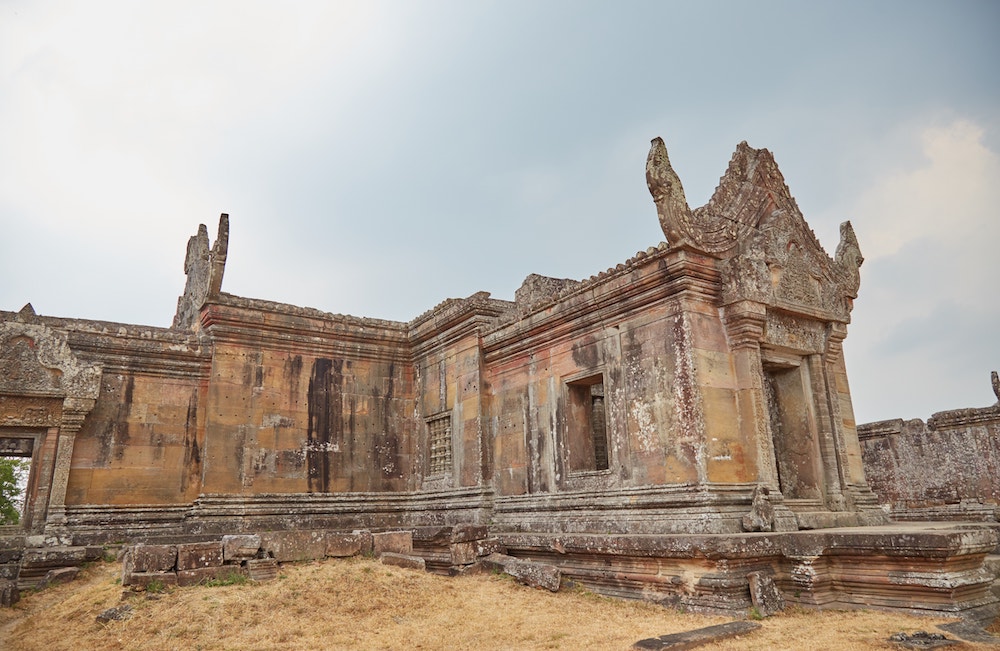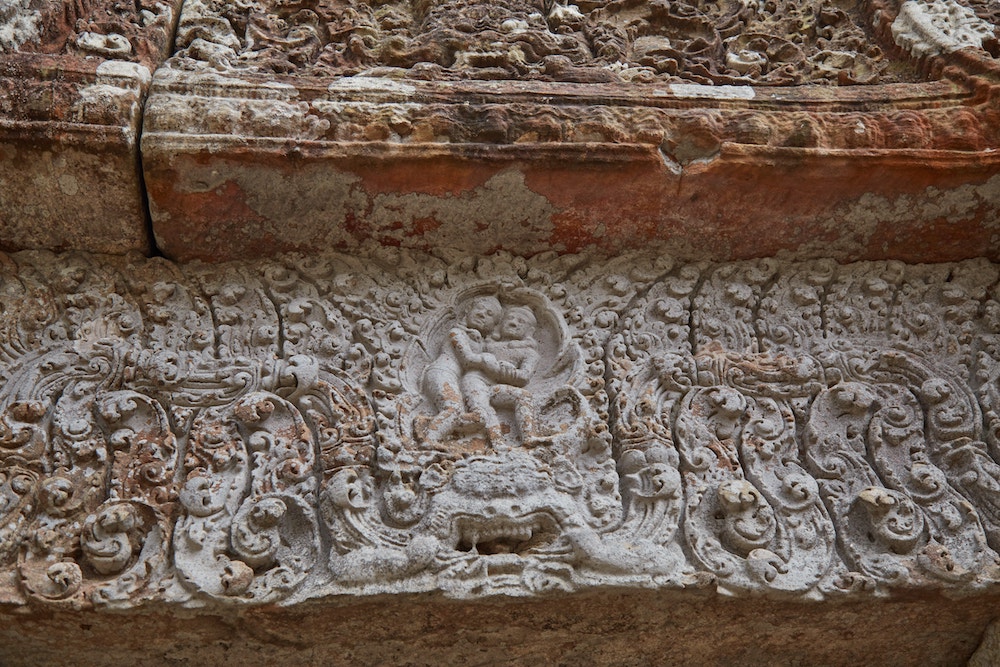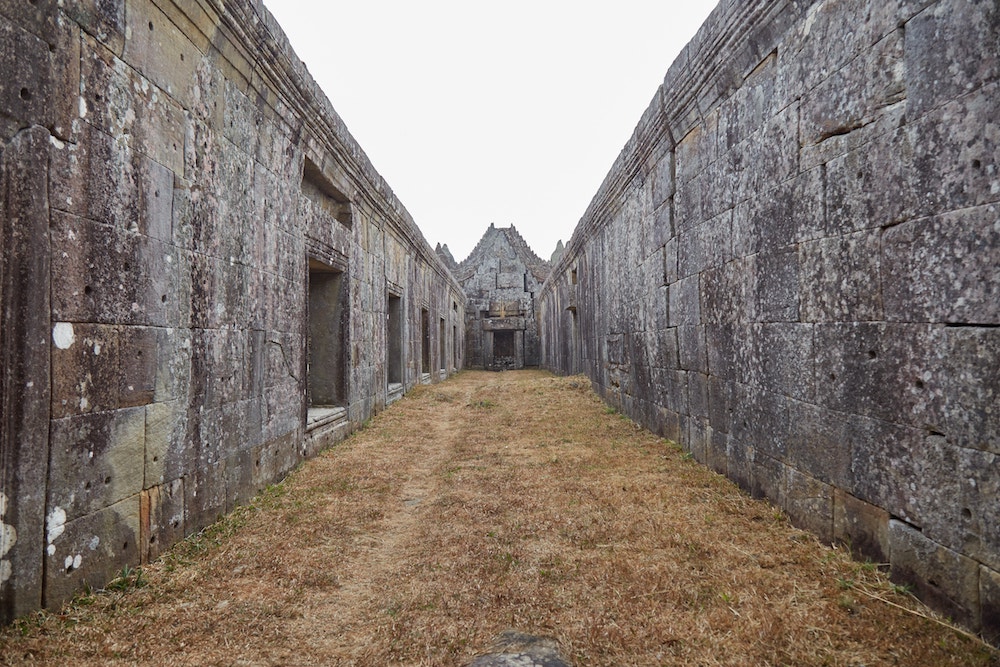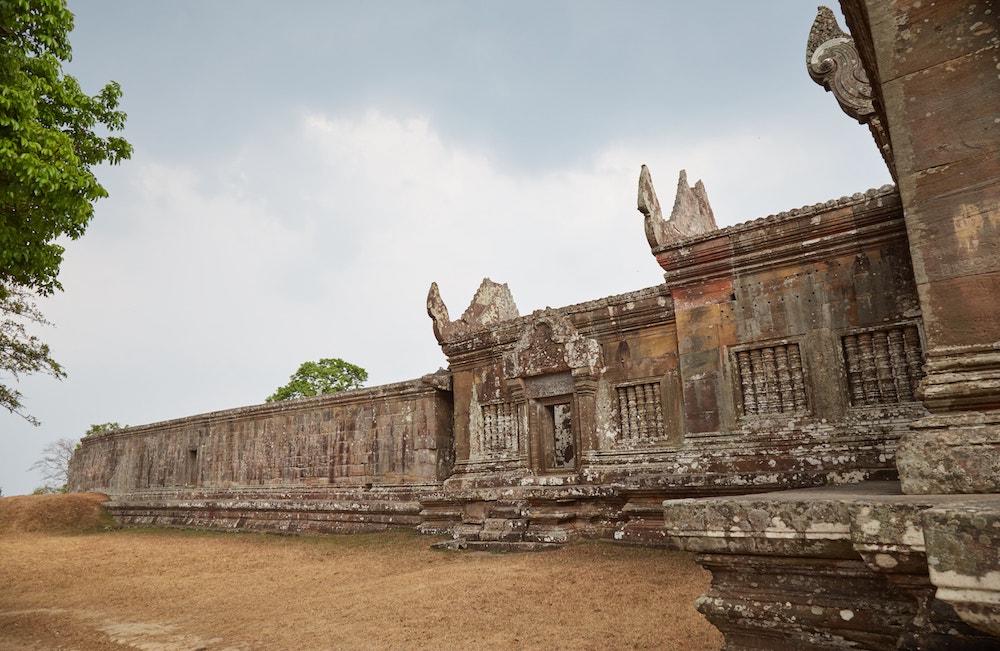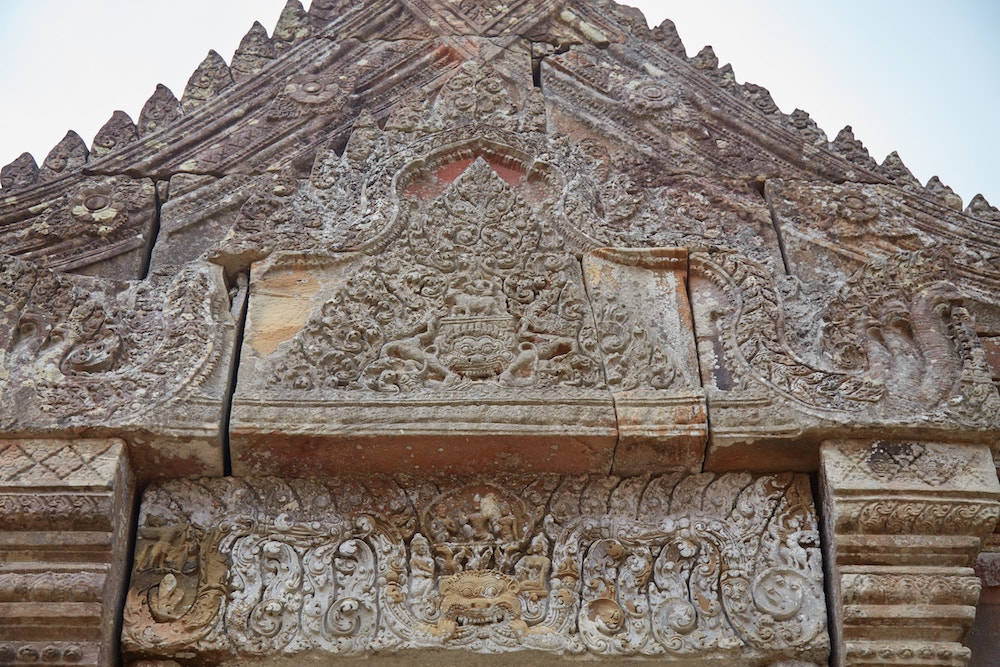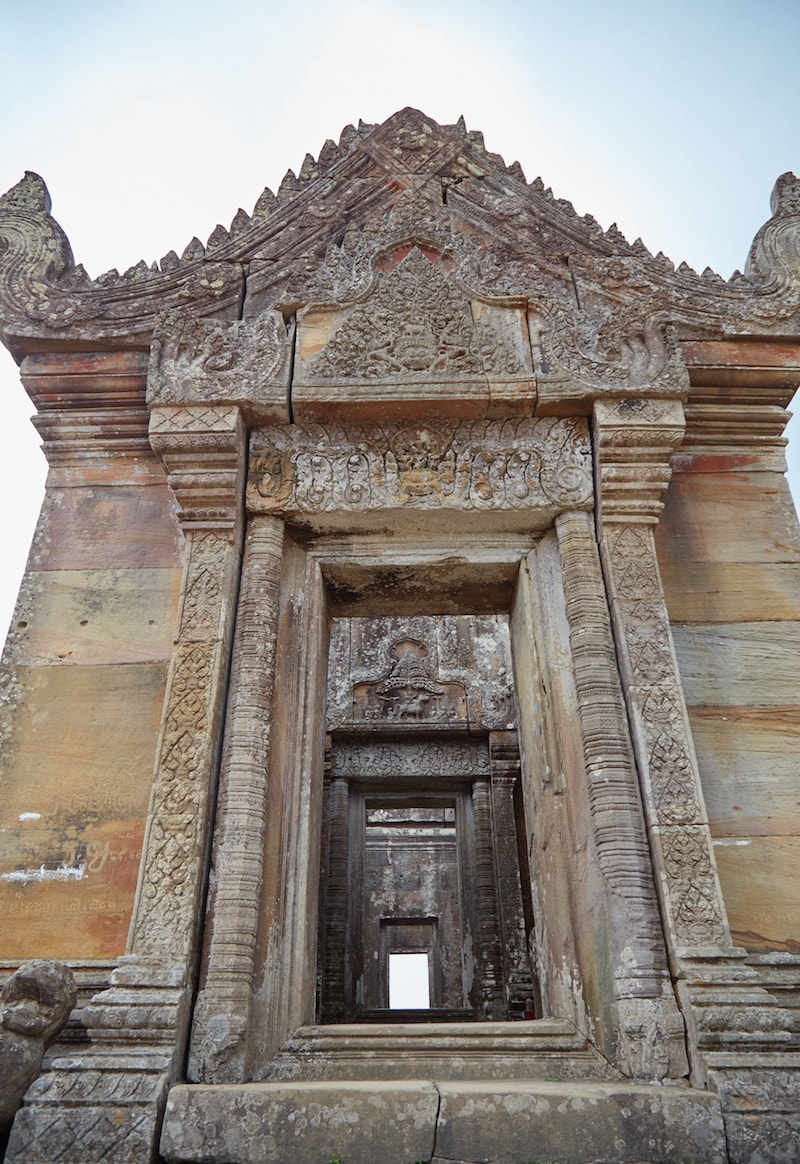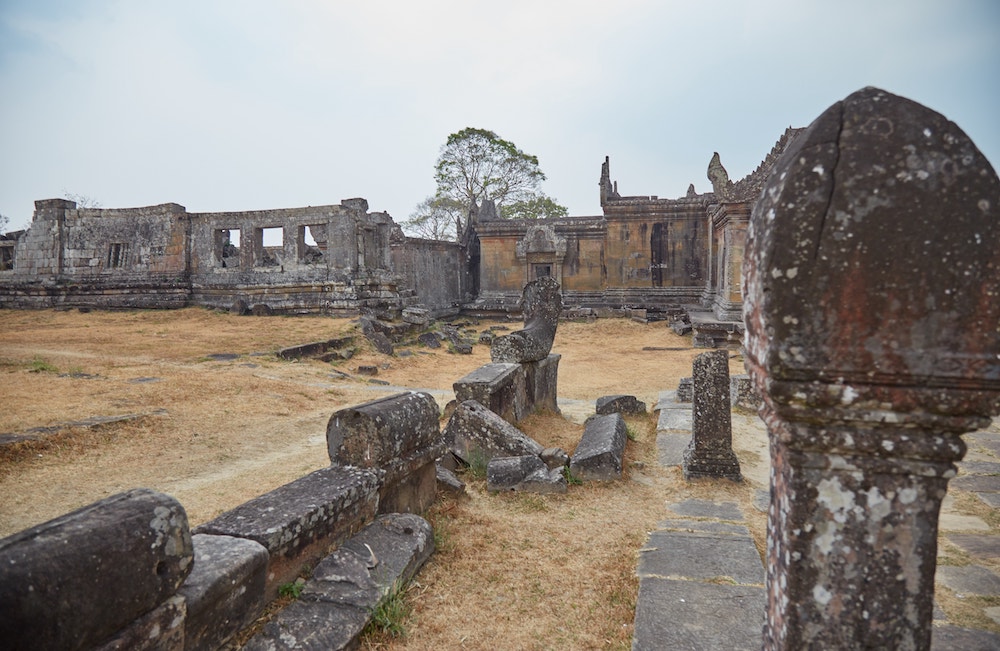Last Updated on: 26th November 2018, 05:49 pm
Amongst the Khmer Empire’s hundreds of temples, no more than a handful were ever built on mountaintops. Of these, Preah Vihear is the largest. Its layout is also unusual, making it one of the most unique temples in the region. But the temple wasn’t even accessible to visitors until 1998. And even within the past decade, violent skirmishes between Cambodia and Thailand resulted in a number of casualties. Fortunately, the land dispute was resolved in international courts and things are much calmer now. During my time in Cambodia, I decided to head up north to the Dangrek mountain range to see this ancient “sky temple,” which also continues to double as a military outpost.
Ascending the Mountain
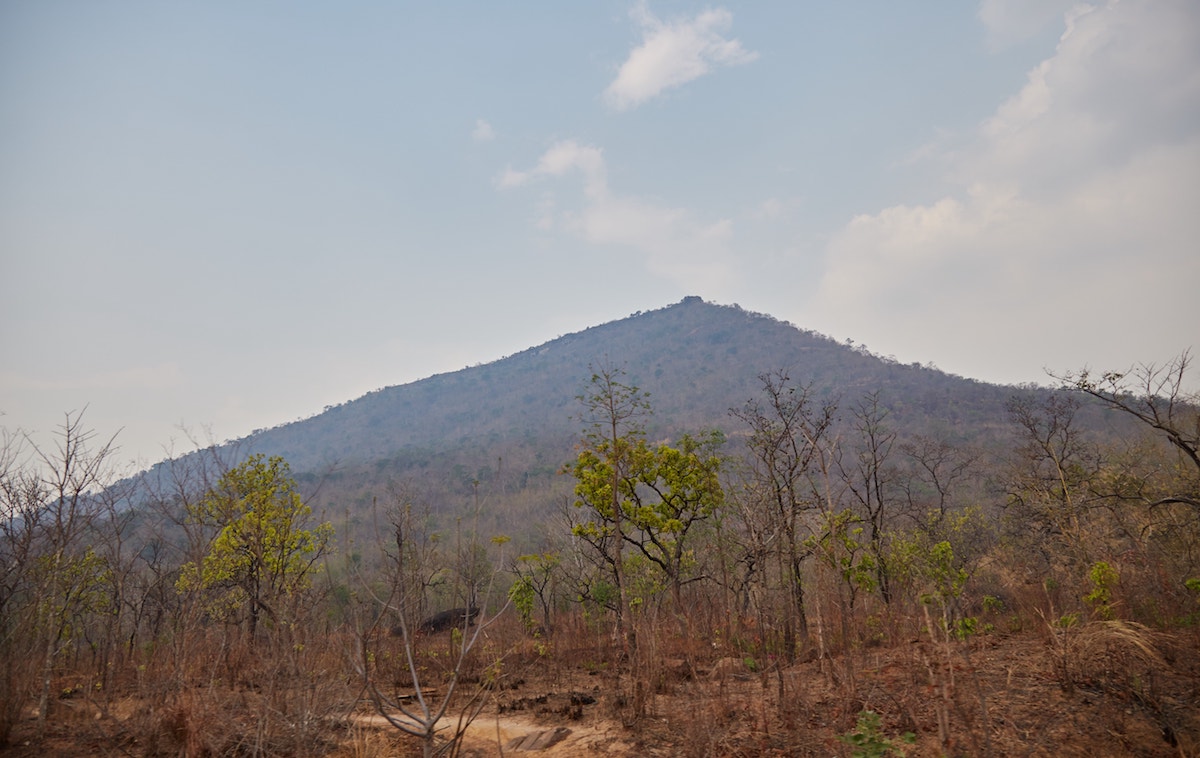
Entry tickets to Preah Vihear are purchased near the base of the mountain itself. You’ll then need to pay an extra $5 for a man on a motorbike to ride you up, and someone (likely the same driver) will also be there to take you back down when finished.
“Which country are you from?” I was asked on numerous occasions, both when buying the ticket and a couple more times by Cambodian soldiers near the temple. I wasn’t asked to show my passport, but it might be a good idea to bring yours just in case. Essentially, they just want to make sure you aren’t Thai (more on the conflict down below).


After getting dropped off and approaching the temple, you’ll come across a dilapidated structure that was once supported by columns and is currently under repair. At this point, you’re actually at the top of the original staircase that the Khmer would’ve used to walk up to the temple. It’s worth climbing down just a little bit to see the excellent seven-headed naga balustrades. Apparently, walking all the way down only leads to a closed gate. On the other side? Thailand.
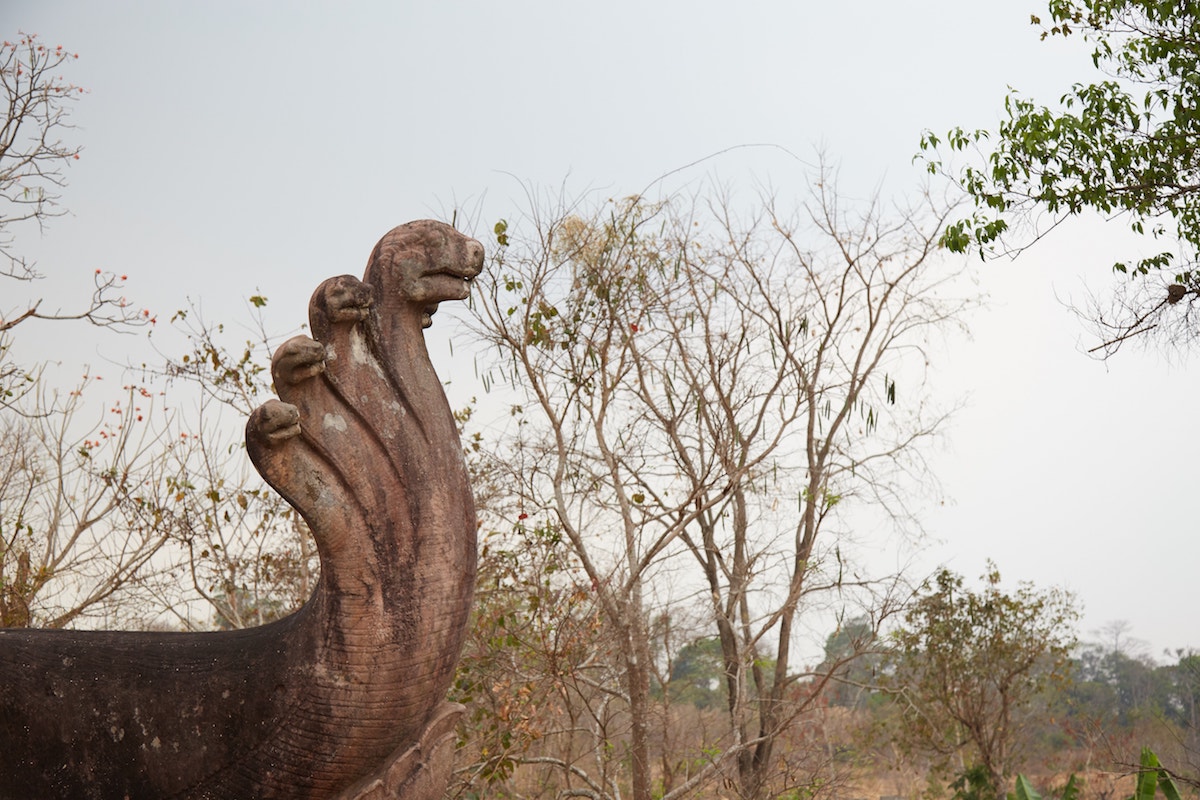
Now turn the opposite direction and start walking up the long sloped causeway. From here it’s another 800 meters before you even reach the temple itself. As this is a Khmer temple, however, its builders added plenty of structures to appreciate along the way.
You’ll pass through a series of three gates as you walk along, and gradually ascend higher up the path. You shouldn’t rush your way to the top, though. The gates are worth exploring, and some of them are as interesting as the main temple itself.
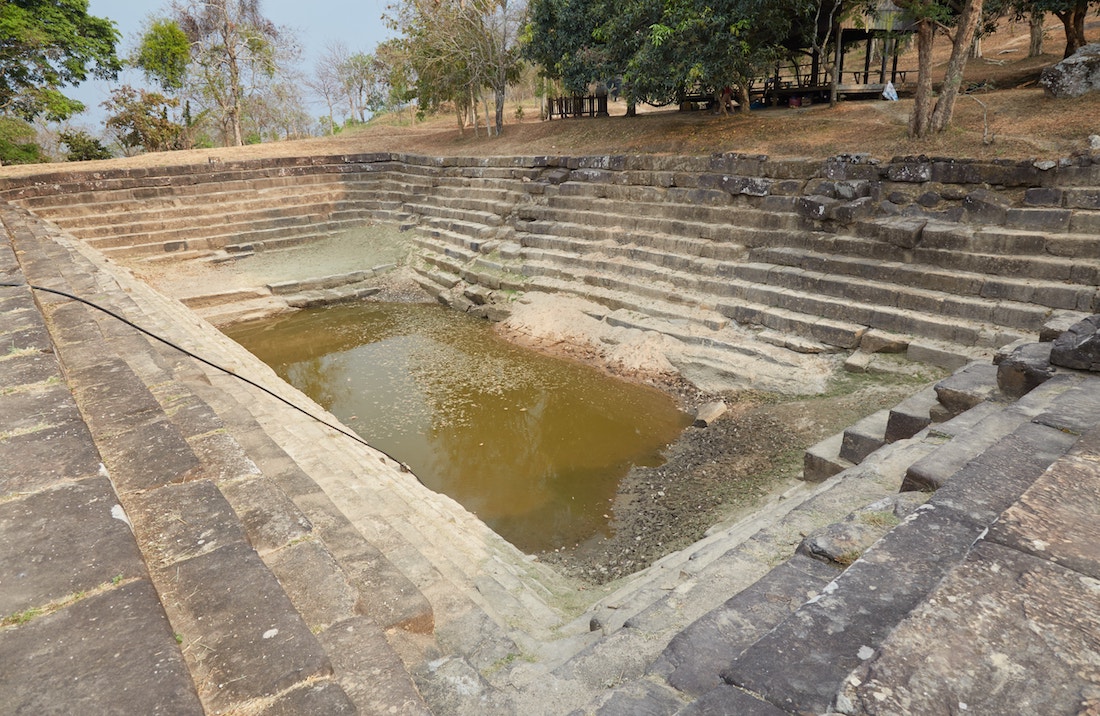
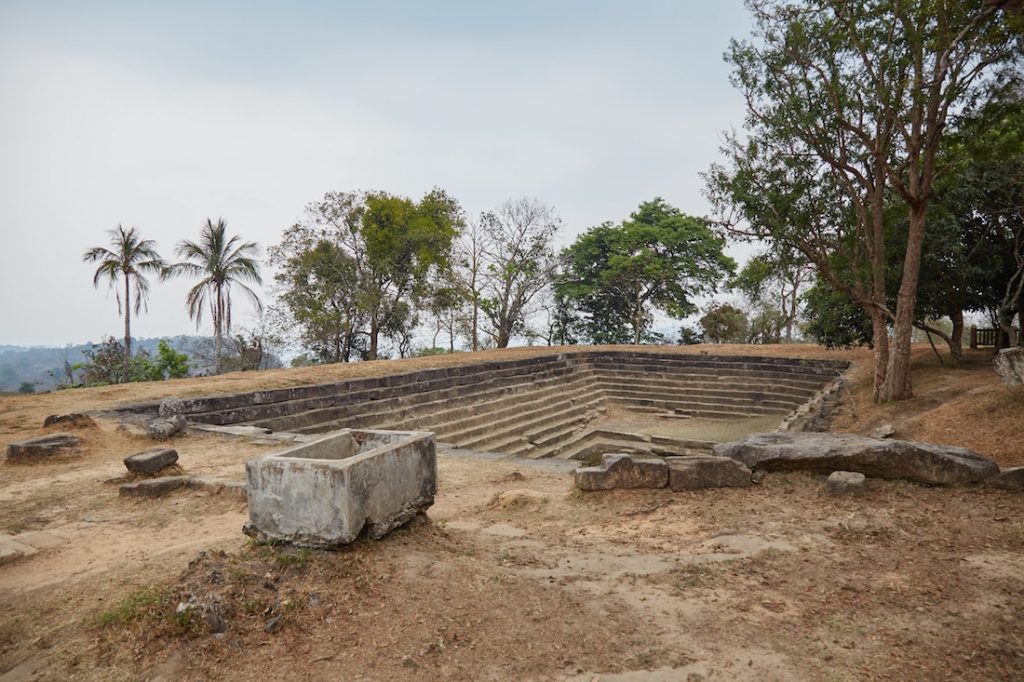
Before arriving at the first gate, you’ll come across two ancient reservoirs, which appear to be some kind of ritual bathing center, or perhaps just a symbolic moat. The Khmer loved to build artificial lakes, ponds and moats, and even the mountaintop Preah Vihear is no exception.
The First Gate
Arriving at the first gate, you’ll notice how open and airy the structure is. Preah Vihear’s use of columns is pretty rare as far as Khmer temples go. The stone base and columns were probably merely the base for a much larger wooden structure that has long since rotted.
You’ll also notice some interesting carvings in the lintels and pediments of the doors, but things only get more interesting the higher up you go. Like the other two gates, this one was built in the shape of a cruciform, which also would’ve been unusual for the time period.




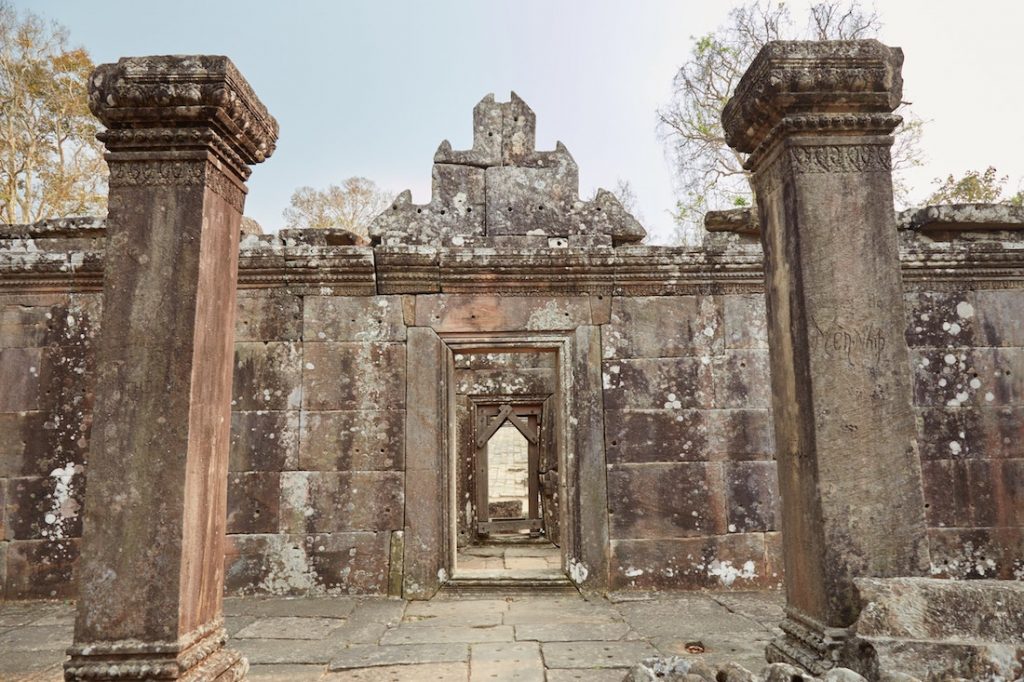
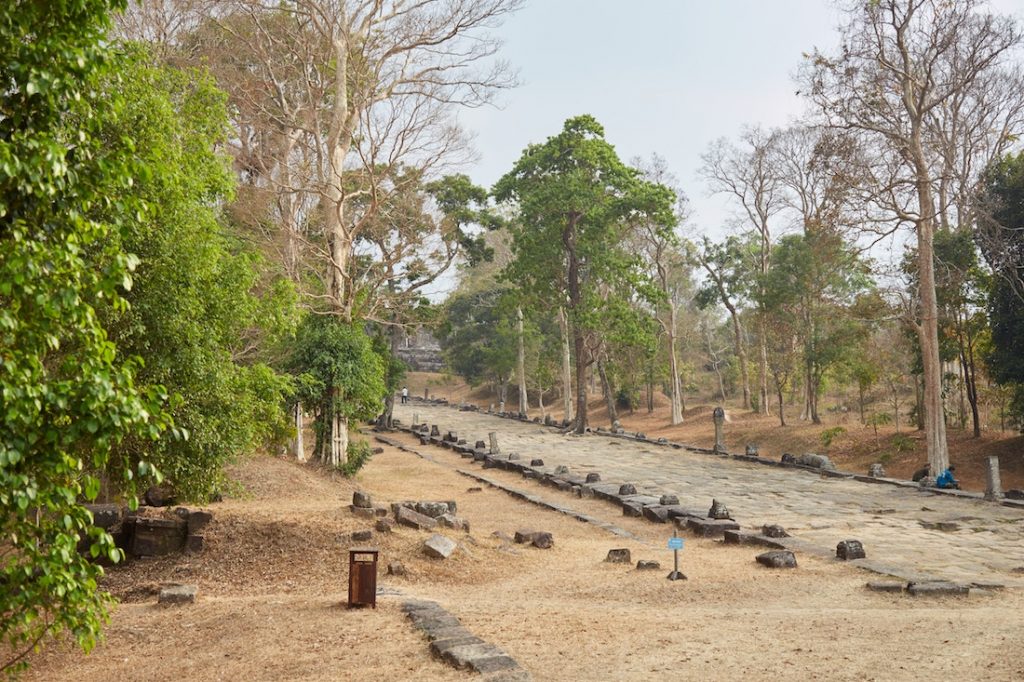

The Second Gate
The second gate is noticeably less open than the first one. Instead of the columns there are long stone hallways that remain in good condition. The carvings here feature the scenes of classic Hindu tales like the Churning of the Ocean of Milk and Krishna splitting the snake Kaliya in two (learn more about both here).
Here you’ll also notice how closely the pediments atop the doors resemble the shape of those found at Banteay Srei, which hardly appear at any other temples in the Angkor region. There’s one more temple where these types of pediments are used, though, and that would be Wat Phu in current-day Champasak, Laos.
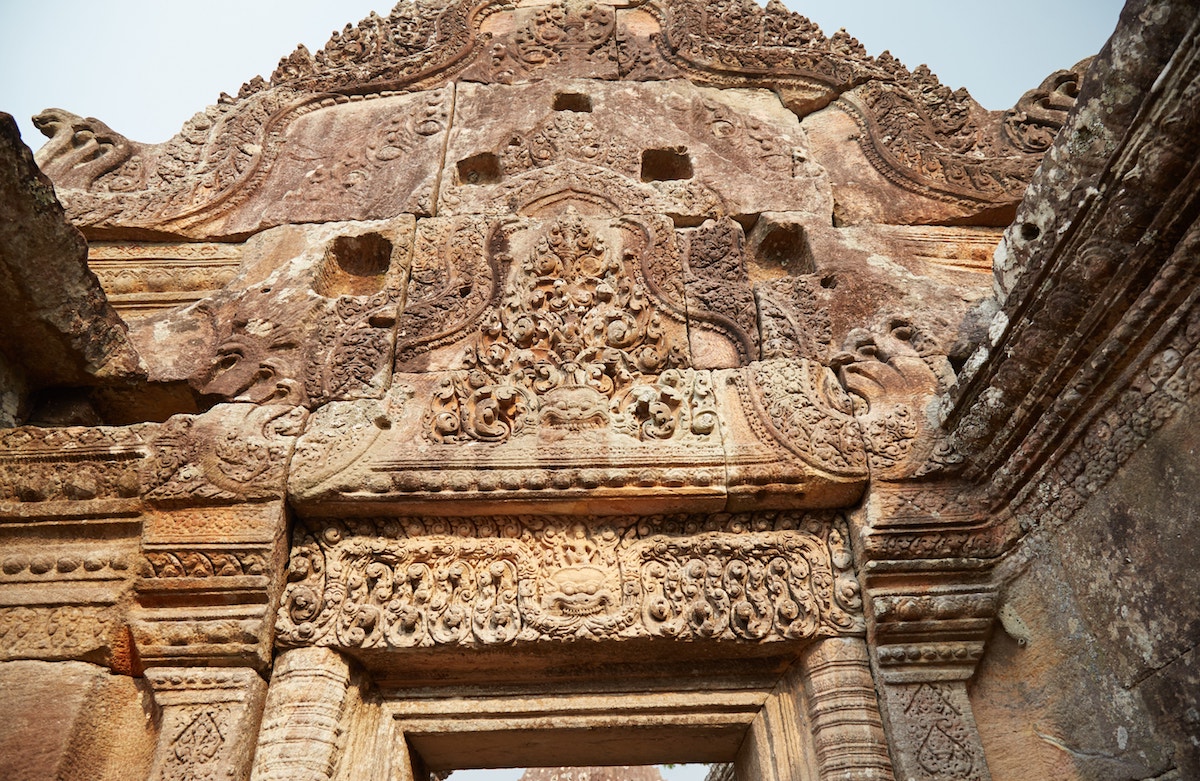
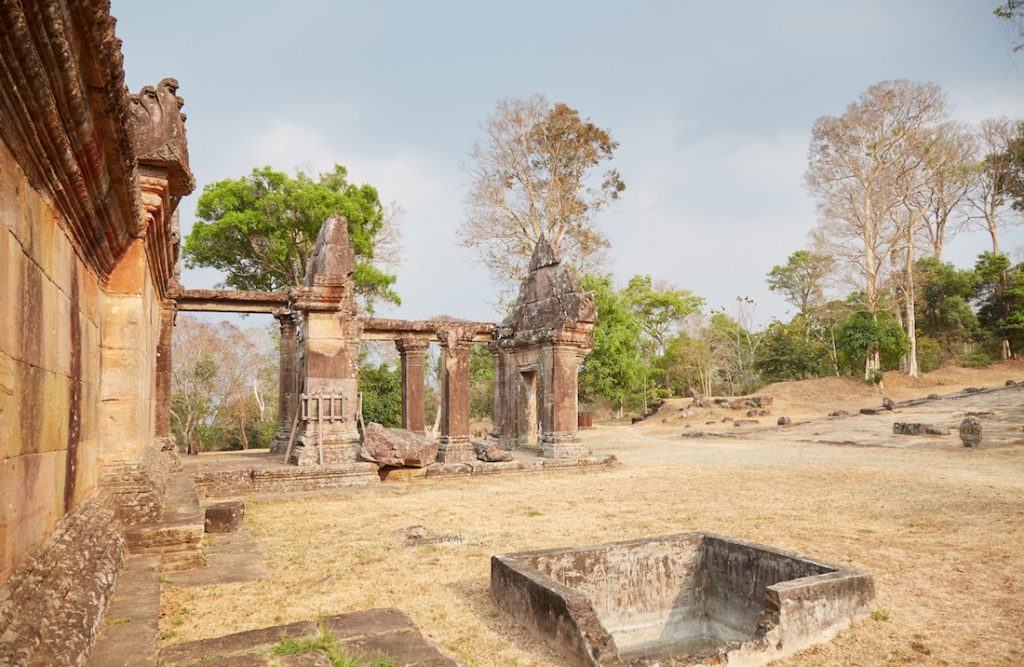

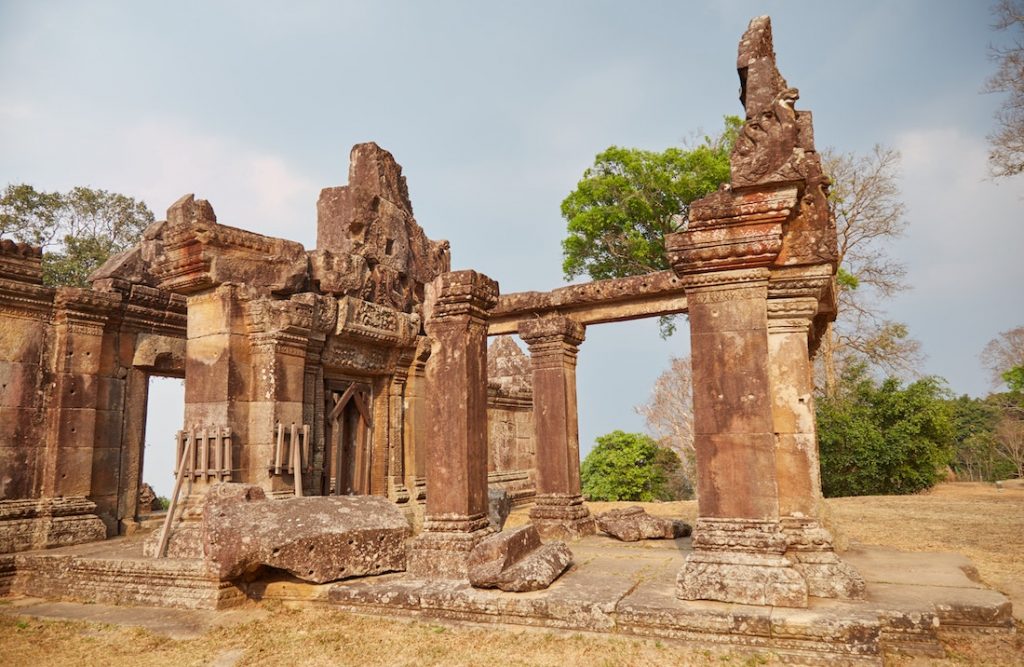
There appear to be a number of connections between Preah Vihear and Wat Phu, both historically and architecturally. Both temples were built on hilltops along a north-south axis. This was extremely rare in the Khmer Empire, where almost every sacred structure was built facing east (with a famous exception being Angkor Wat, which faces west.)
According to an ancient inscription, Indrayudha, the son of Jayavarman II (Angkor’s first ruler) brought a fragment of the shiva linga contained at Wat Phu and brought it to the site of Preah Vihear. While I have yet to visit Wat Phu myself, the linga there is supposedly a natural formation and not a manmade one, thus long predating the Khmer Empire.
Preah Vihear was one of the Khmer Empire’s most important Shiva temples. Shiva has a strong association with mountains, as his mythical abode is at the peak of Mt. Kailash, a mountain which really exists in present-day Tibet. The Khmer Empire itself was founded atop Mt. Kulen, while the mountaintop temple Phnom Bakheng was also meant to represent Mt. Kailash. Considering Preah Vihear’s size, though, this may have been the most significant. As Khmer kings traditionally identified themselves as incarnations of Shiva, they most likely would’ve made royal pilgrimages here from Angkor.
The Third Gate

The third and final gate is the largest and most elaborate of them all. it remains in good condition, and you can step inside to take a walk down the long and narrow hallway. It’s quite reminiscent of the North and South Khleangs in Angkor Thom, and like those two mysterious structures, we’re not exactly sure what these gates were used for. Either they housed sacred relics and texts, or merely acted as resting places for visiting dignitaries.
Walking around, you’ll come across scenes from the Ramayana epic, a carving of Shiva and his consort Uma, and Krishna killing a demon horse. The carvings at Preah Vihear are highly refined. This isn’t too surprising considering how it was built around the same time as Banteay Srei, the masterpiece of Khmer art. Perhaps even some of the same artists were hired.
Off to one side, you’ll also notice a small structure that may predate the gate itself. Its origins and true purpose, however, remain unknown.
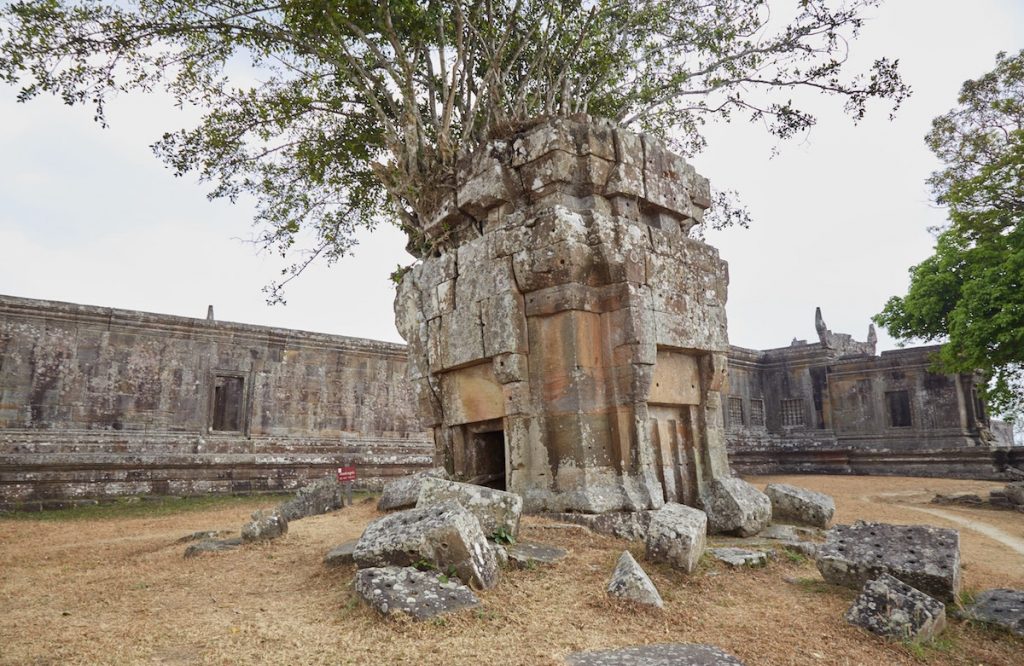
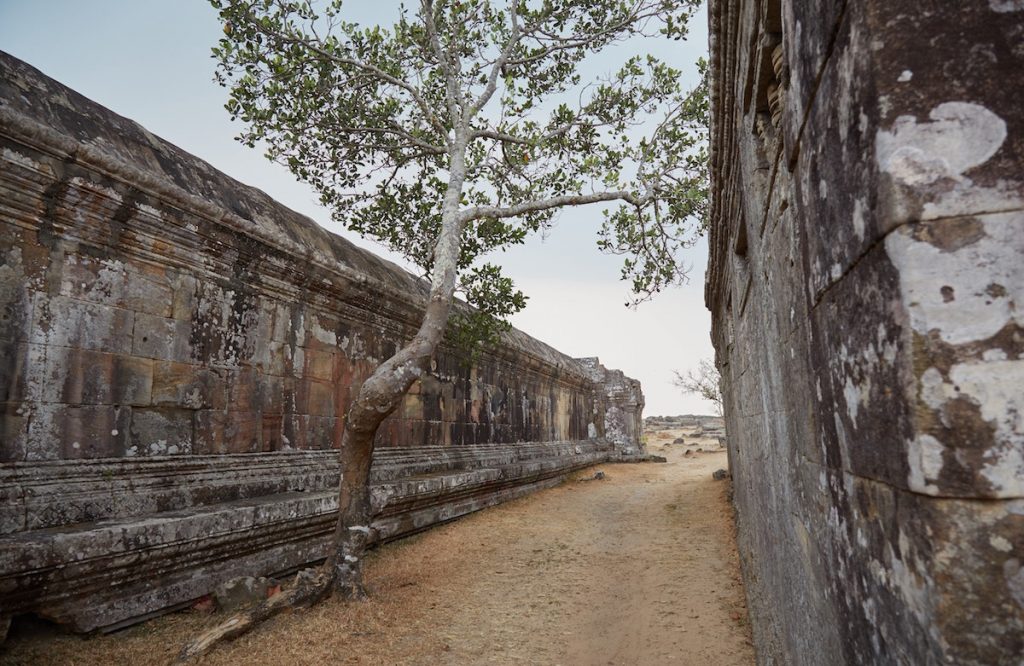
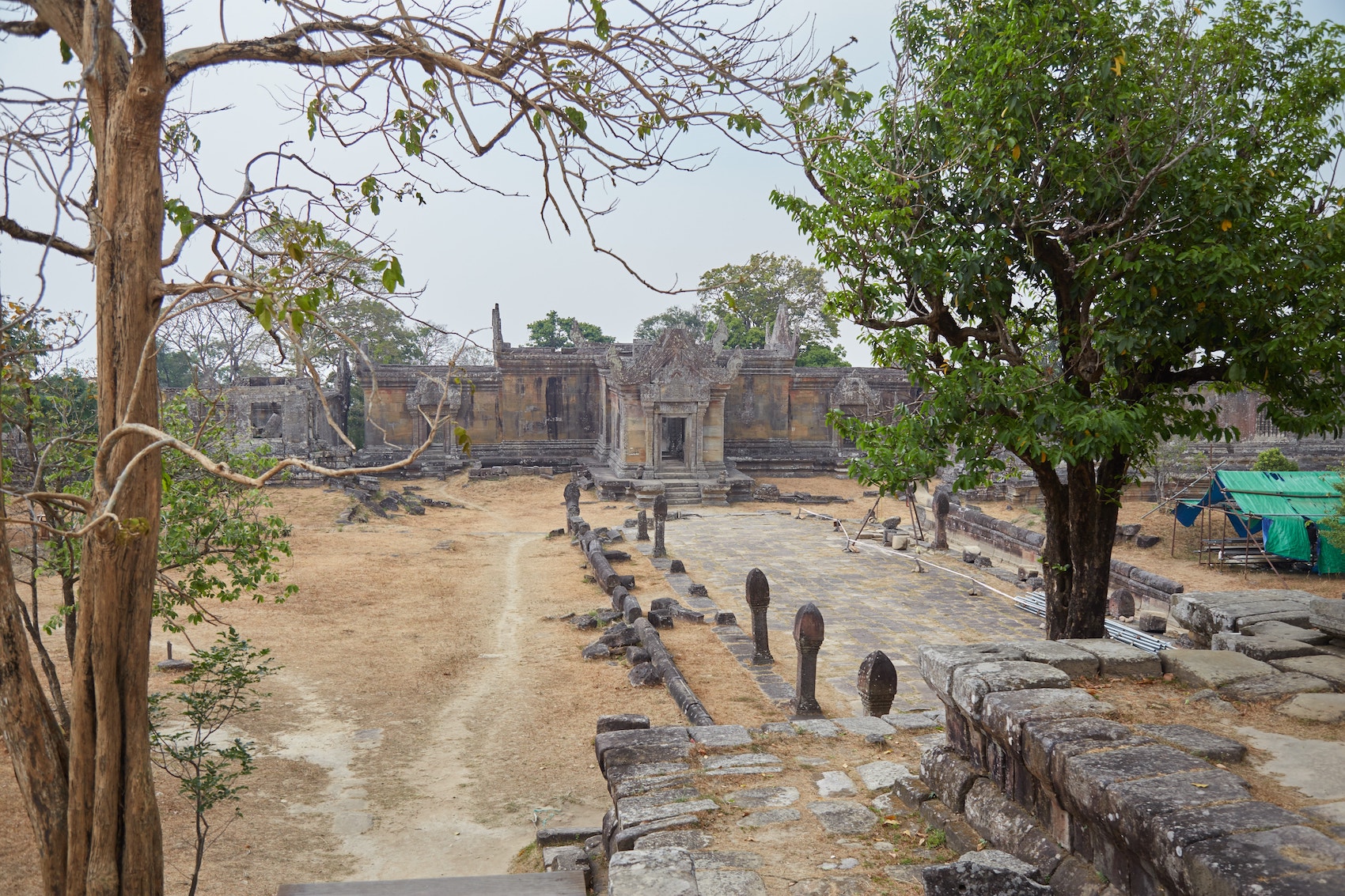
The Main Temple
Just outside the third gate is the main temple itself. At first glance, it’s not that easy to tell what you’re looking at. Not only have many of the structures collapsed, but the layout here is rather unusual for a Khmer temple. The first enclosure contains a large hall, surrounded on either side by “libraries,” common Angkorian buildings whose purpose we don’t really know.
The central sanctuary is now just a pile of rubble, but it would’ve also featured a gopura attached to the front entrance – a feature first introduced at Banteay Srei. But unlike its contemporary temples, Preah Vihear seems to have used a lot of wood, which helps explains all the exposed columns.

The temple is largely attributed to Suryavarman I, who reigned from 1002-1050. As mentioned above, some type of worship was taking place at the spot even hundreds of years earlier, though the original shrine can no longer be found. Suryavarman I likely built the temple and gates we see today. But as with many other structures in Cambodia, it was gradually added to by later kings. Regardless of the date, what an effort it must’ve been to drag up all this stone to the mountaintop!
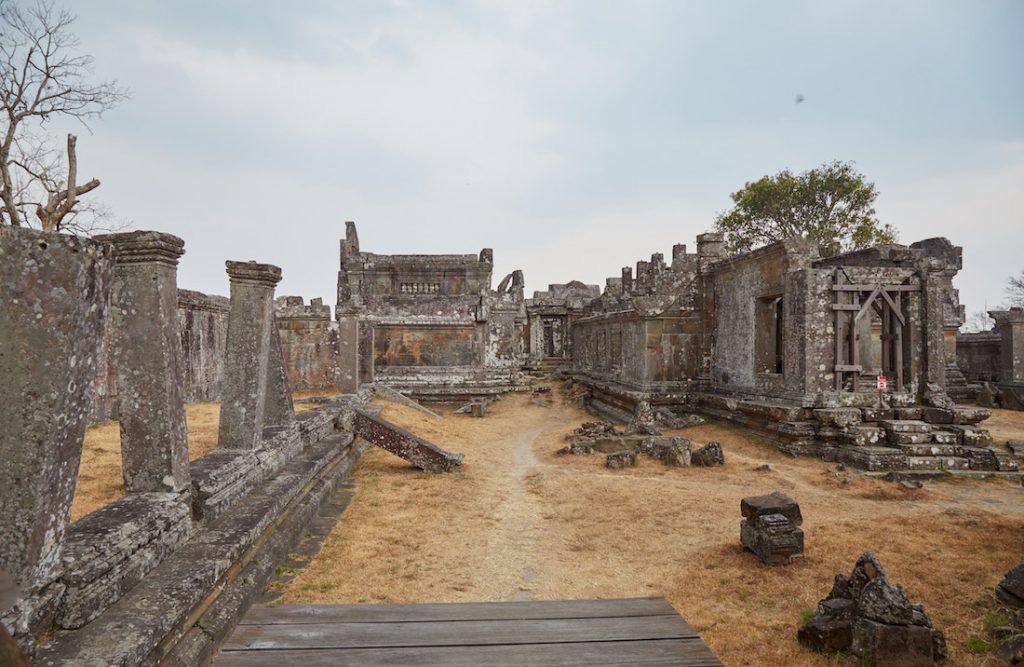
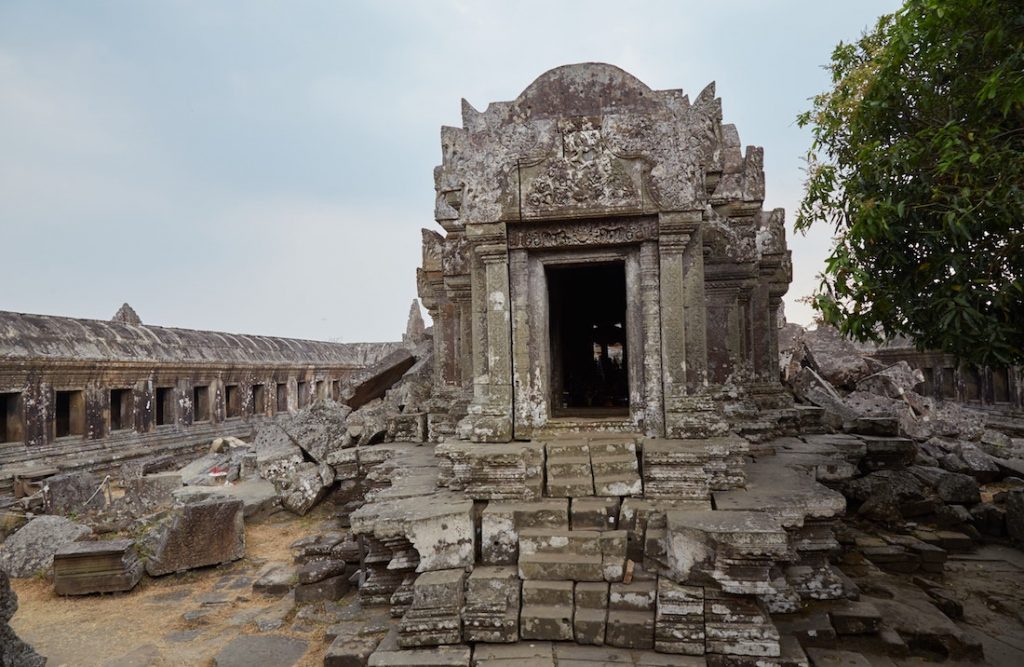
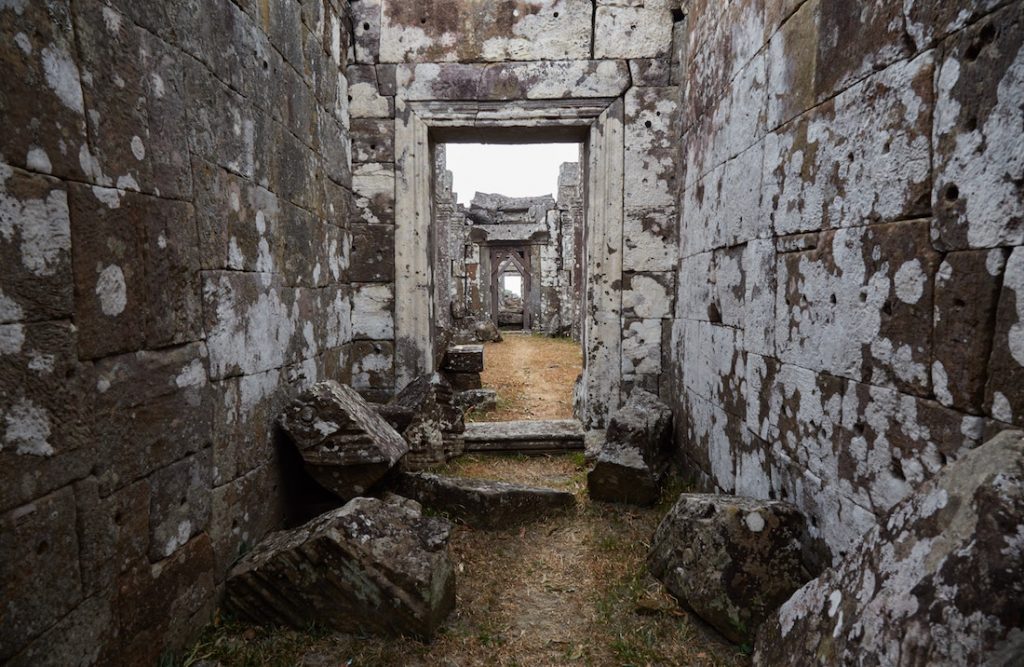
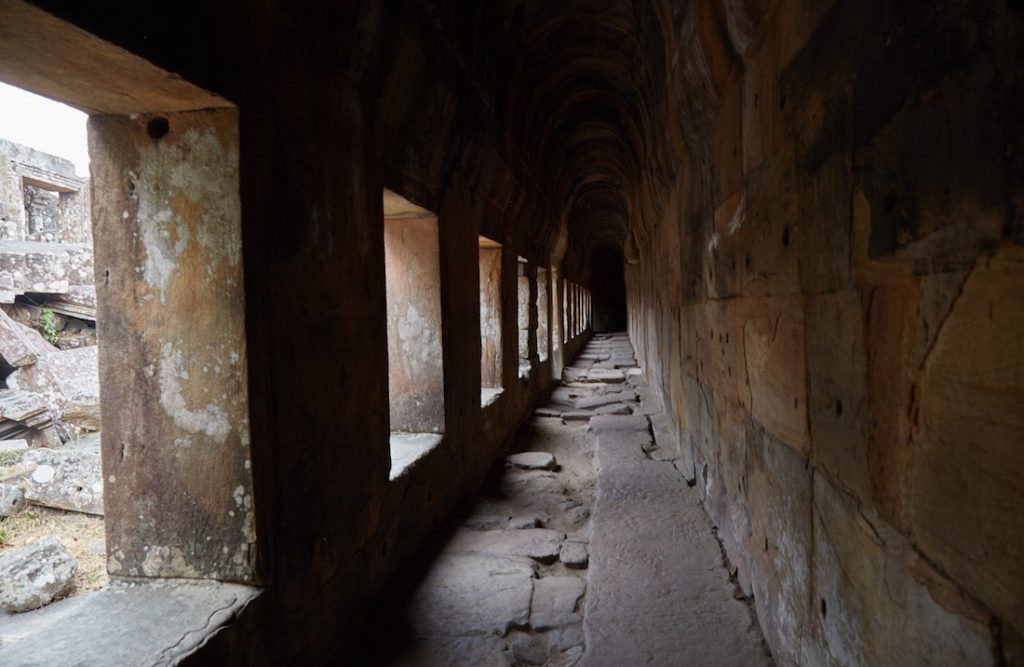
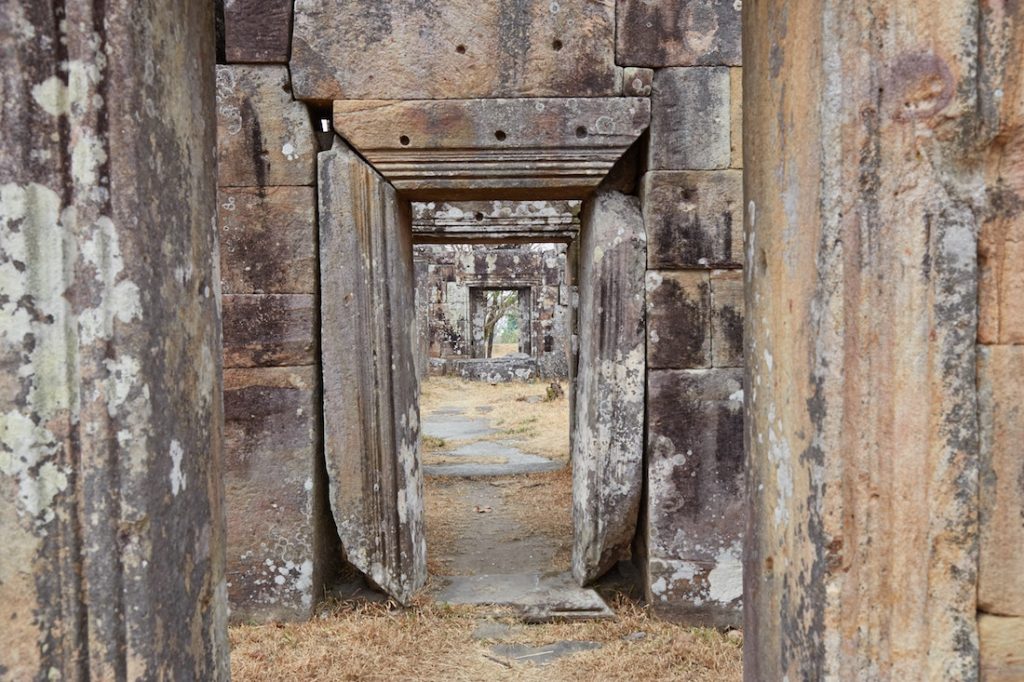
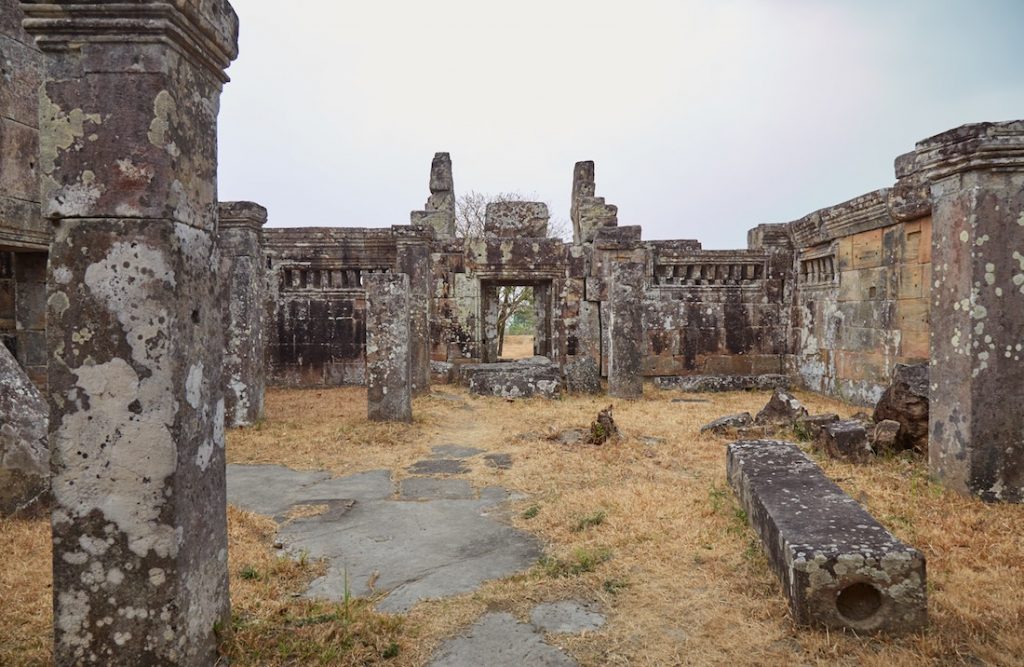
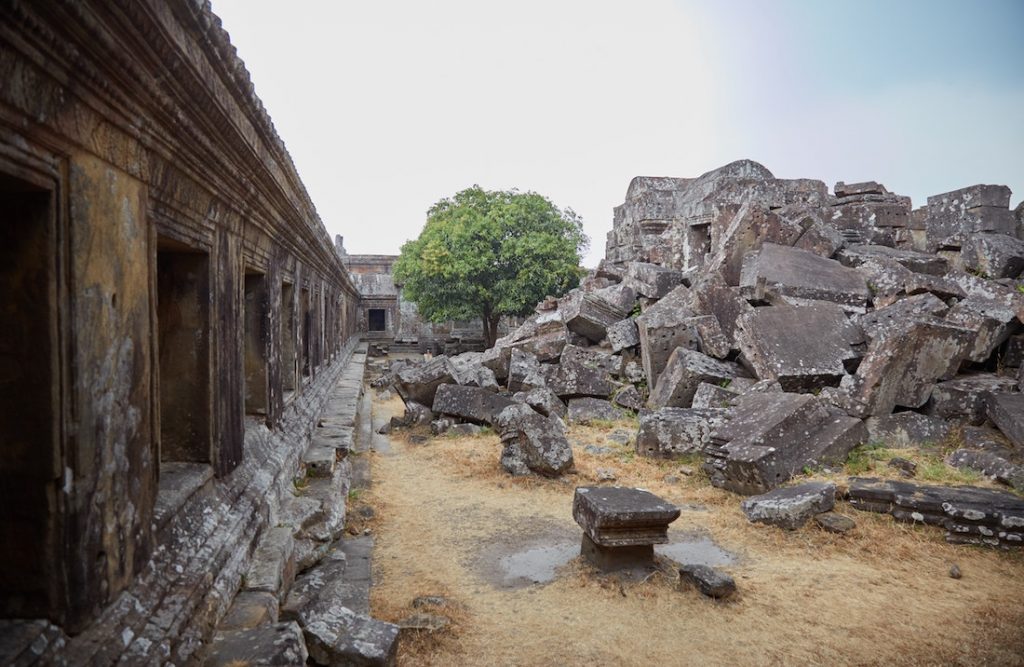
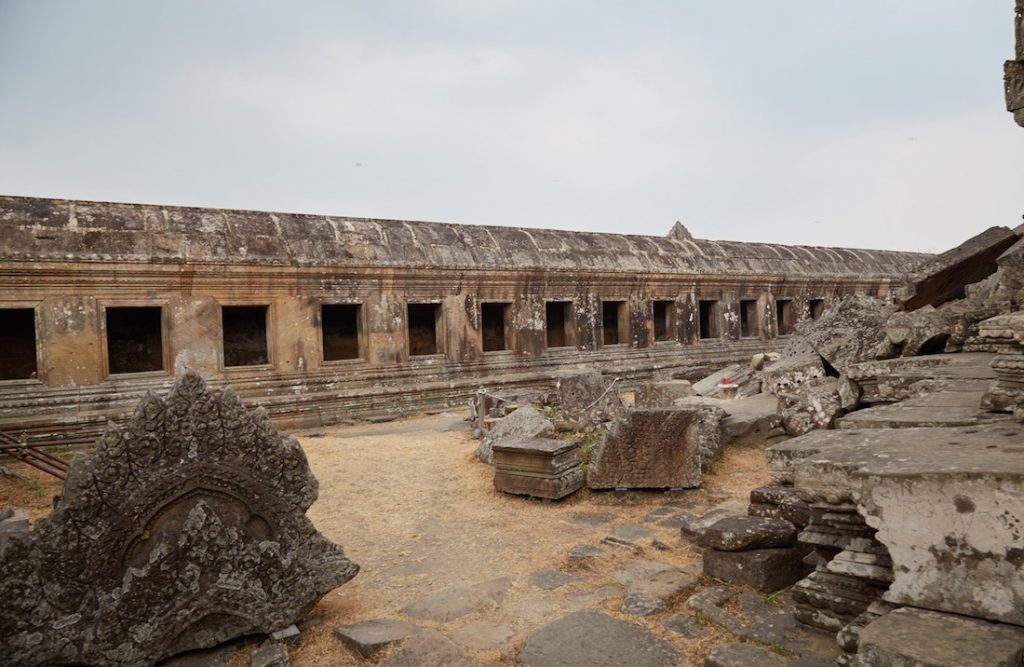
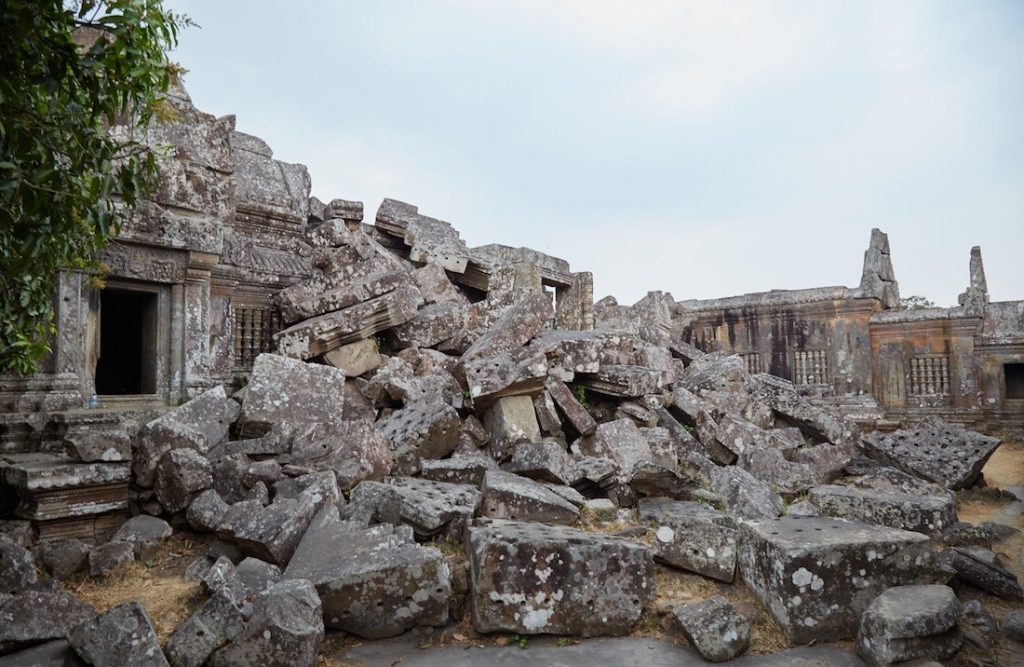

The fun doesn’t end with the temple. Exiting from out the other end, you’ll reach the side of the cliff where you can appreciate the view. Or, at least if you’re lucky enough to get there when it’s clear. During my visit, it seemed to be ‘burning season’ in Cambodia, the time when farmers all burn their organic waste at the same time. I could barely make out the landscape through all the haze.
Needless to say, it was a somewhat anticlimactic end to the trek. But I’m glad I stuck around to explore a little further.
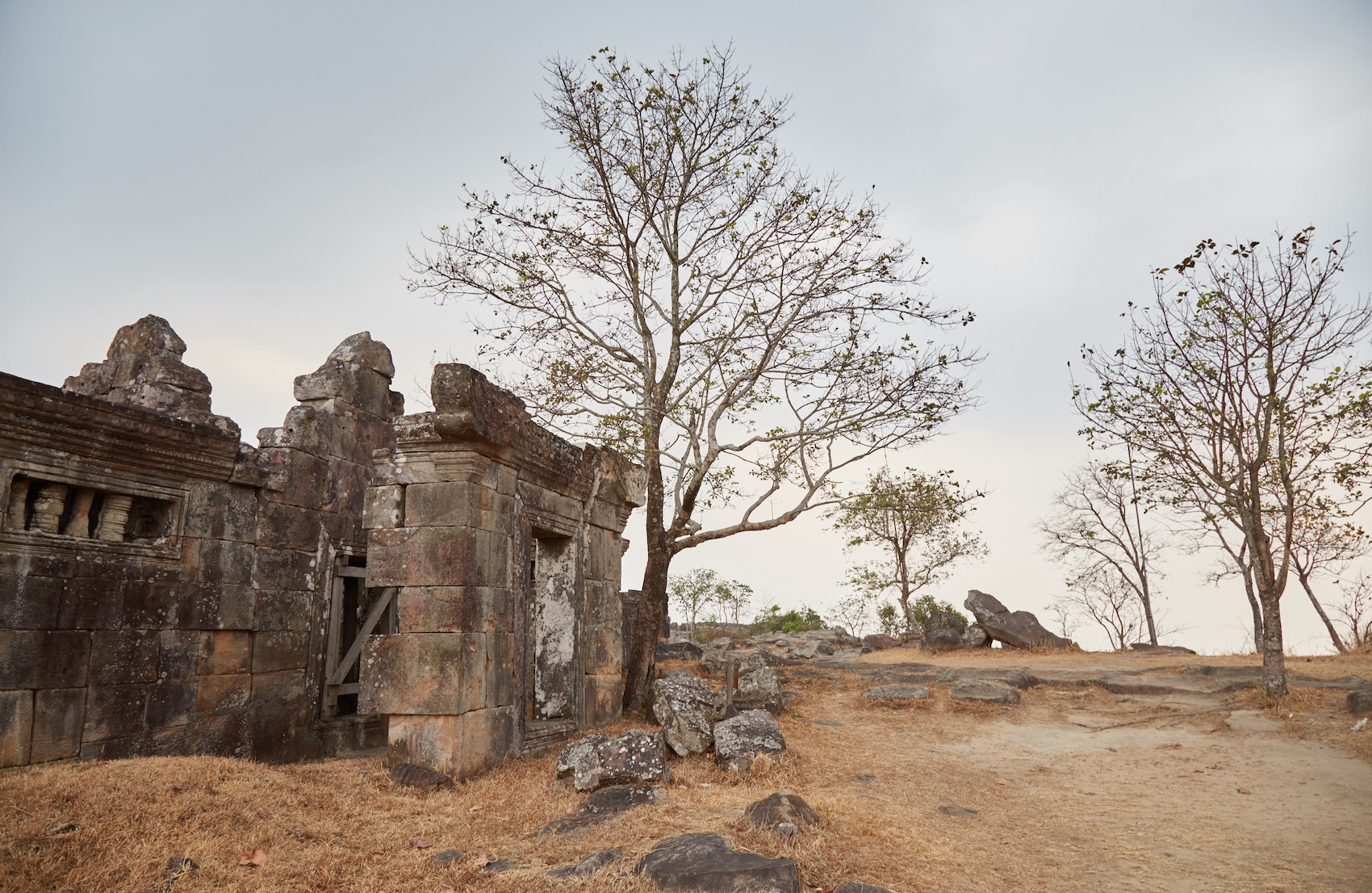
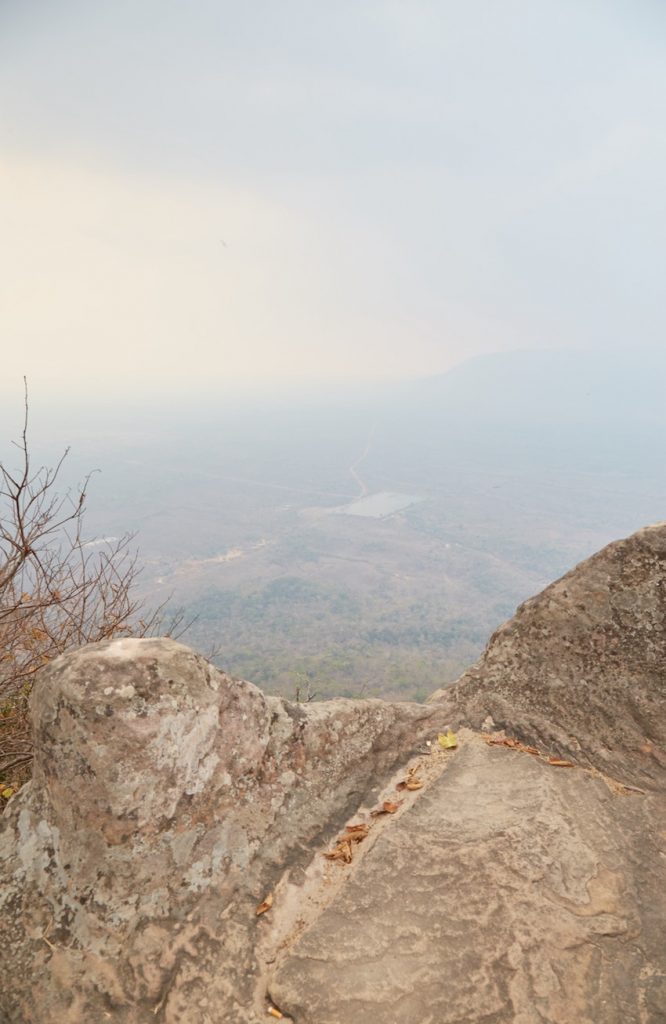




Walking around the cliffside area, I came across a little shrine within the rock that wasn’t visible from the edge of the cliff. On one side was a shrine with various offerings, while on the other were sandbags and barbed wire.
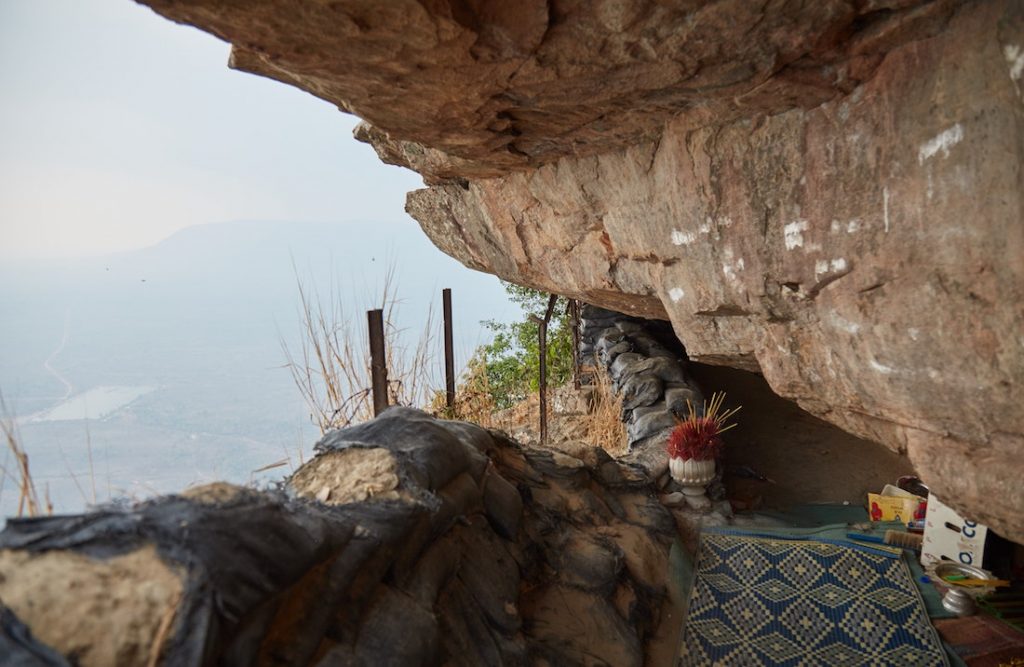

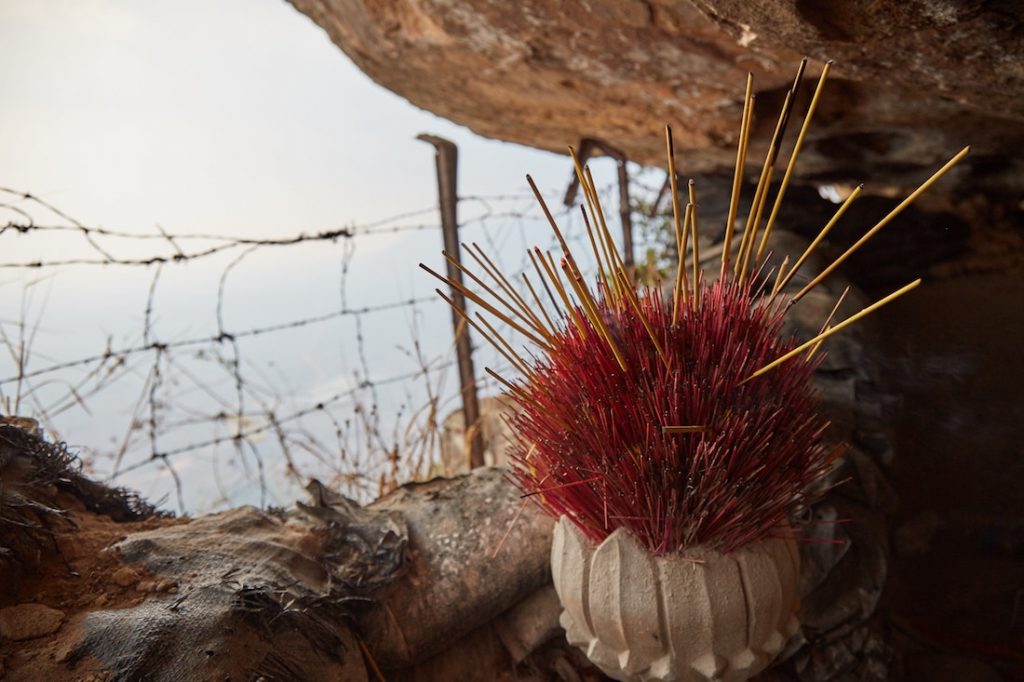
Was this a shrine dedicated to the lives lost in the conflict with Thailand? Or was it something much more ancient? Whatever the case may be, the altar, the incense, the barbed wire and the mountaintop views all came together to sum up Preah Vihear’s long and eventful history.
The Land Dispute
Up until very recently, the temple of Preah Vihear and the territory around it were in dispute for decades. After the French colonialists left Cambodia, the border between Cambodia and Thailand was never officially resolved. The two countries took the matter to the International Court of Justice in 1962, who ruled in favor of Cambodia. For whatever reason, though, the ICJ failed to make a clear ruling on the land surrounding the temple, and the area remained in dispute.
Preah Vihear was actually accessible from both countries for many years. In 2008, the temple was declared a UNESCO World Heritage Site, which reignited tensions over which country owned it. Over the next three years, fighting would break out that ultimately ended in the death of 8 soldiers. Thousands of civilians had to be displaced and there was also slight damage to the temple itself.
In 2013, the two sides took the matter to the ICJ yet again, who ruled in favor of Cambodia for a second time. The temple is no longer accessible from the Thai side, though they have a military base on a nearby mountain. At the temple itself, Cambodian military presence remains strong. For the time being, at least, things appear to be peaceful.
By the time I left the temple, it was near closing time. The long causeway, I noticed, is just as scenic on the way back as it is on the ascent. Being the last visitor left, I took some time to do some further exploring, before finding the driver to take me back down the mountain. I was lucky, as just after leaving the temple, it started pouring rain.

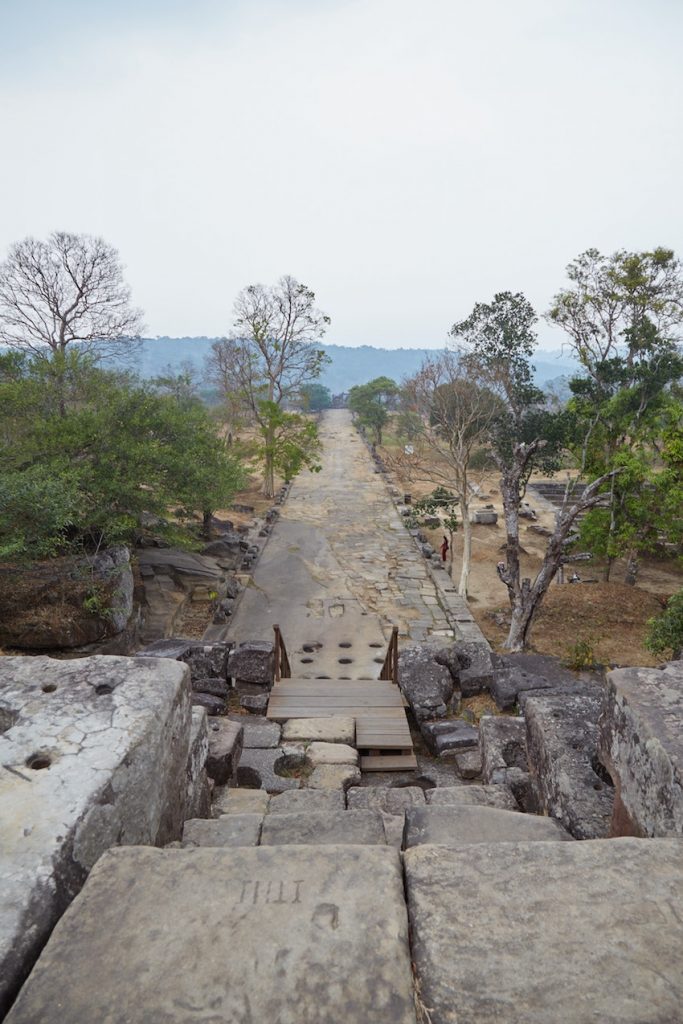

Is Preah Vihear Worth Visiting?
The simple answer is yes. It’s harder to determine, however, if the trip to Preah Vihear and back, stopping at no other temples, is worth the long journey and cost from Siem Reap. With my lack of a view from the top, I probably would’ve been a little disappointed had I paid for private transport from Siem Reap and back. As I included Preah Vihear on a three-day outlying temple tour, though, I was able to visit the temple at a very good value (see more below). If you only have time to visit one of the major outlying temples in Cambodia, I would probably recommend Koh Ker. If you have the time, though, seeing all the outlying temples in three days is absolutely worth it.
Additional Info
Access to the temple costs $10. However, you will also need to pay $5 for transport up if you go on the back of a motorbike, and $25 if you’re a group needing a van.
Supposedly, the Cambodians recently built a new staircase which allows one to get all the way to the top of the mountain on foot, but I didn’t notice any signs about this during my visit (and wouldn’t have had the time anyway). The original ancient staircase connects with Thailand, so when the motorbike drops you off you simply begin your journey at the beginning of the long causeway.
It’s possible to visit Preah Vihear as a day trip from Siem Reap, though you’d need to leave very early at around 5:30am. As no direct public transportation exists, you’d have to make arrangements with a private driver.
If you plan on taking public transportation to the nearest town, bear in mind that there is a small city called Preah Vihear but that’s not the closest town. It’s an even smaller town called Sra’em. After my visit to the temple I spent the night in Sra’em and it wasn’t an issue to find a hotel without any reservations. Plenty of tourists pass through the town so there’s a decent number of hotels with English-speaking staff.
Getting to Sra’em itself may be a little tricky as information about Cambodia’s bus schedules are very hard to find online. Oftentimes, the cheapest options are not your typical buses but shared taxis (minivans). To save yourself time, uncertainty (and in the long run, possibly even money) I’d recommend hiring a private driver.
As amazing as the Angkor Archaeological Park is, Cambodia as a whole contains several other significant temple ruins that are absolutely worth the visit.
These include Sambor Prei Kuk, Preah Khan of Kampong Svay, Preah Vihear, Koh Ker, Beng Mealea and Banteay Chmar.
The problem is, though, that these temples are far from easy or cheap to get to. Furthermore, some of them are just a little too far for a single day trip from Siem Reap. And while you may be able to find a private bus or shared minivan from Siem Reap to the town closest to a particular temple, you’ll then have to negotiate with local taxi drivers each time.
To save yourself time, money and uncertainty, I’d highly recommend you hire a private driver from Siem Reap to take you on a 3 day, 2 night temple tour.
The itinerary goes something like this: Depart from Siem Reap in the morning and begin at Sambor Prei Kuk. If time allows, also stop at the nearby Phnom Santuk, which is not a Khmer ruin but still worth a visit.
Spend the night in the city of Kampong Thom. Depart early the next morning to visit Preah Khan of Kampong Svay (not to be confused with Angkor’s Preah Khan) and its outlying temples. Head north, and if time allows, visit Preah Vihear before it closes in the evening. Then spend the night in the town of Sra’aem.
Next morning, head to Koh Ker (or Preah Vihear first if you couldn’t make it the previous day). Finally, on your way back, stop at Beng Mealea.
You should be able to arrange a driver, with the help of your hotel, for the above route for around $300 USD. It sounds expensive, and it is, but it’s actually cheaper and much more viable than visiting all these temples separately from Siem Reap. None of the temples listed above are directly accessible via public transport, and group tours from the city don’t go to them, except for maybe Beng Mealea.
A hotel in these towns should cost $10-15, while the temples themselves cost around $5-10 each.
Because of its location, you wouldn’t be able to include Banteay Chmar on this three-day trip. You’d have to make that a separate excursion, but luckily it’s fairly easy and cheap to reach with public and private transport.
You can check this web site for more in depth articles on each of the temples listed above.
I had no idea about this until after my visit, but Preah Vihear is apparently a very risky place for malaria. As most of Cambodia is considered safe, I never bothered to check each individual district. But Preah Vihear’s mosquitos are so bad that they’ve even become resistant to all types of malaria medication!
Therefore, since medication won’t even help you, wear long pants, apply bug spray and avoid going at dusk. I didn’t follow any of those rules, showing up in shorts right before sundown and without any bug spray. I only got bit once and did not get sick, but it’d be smart to take more precaution than I did when you visit.

